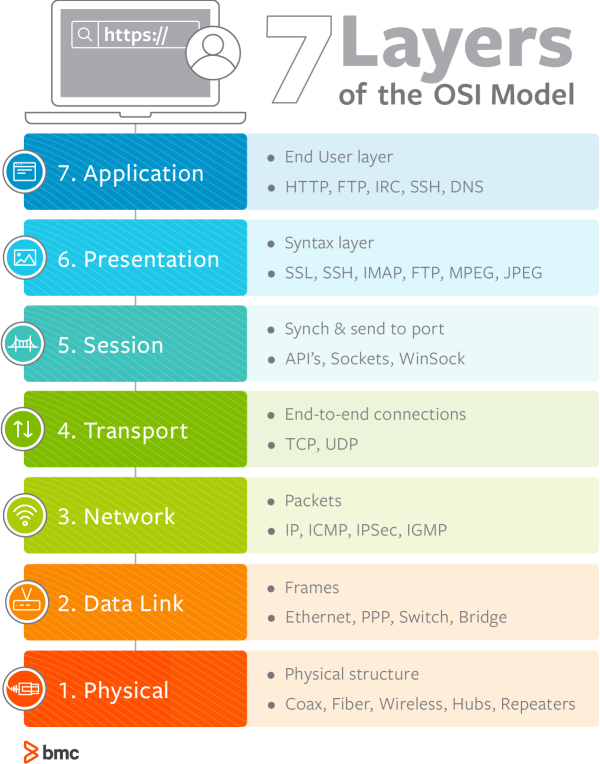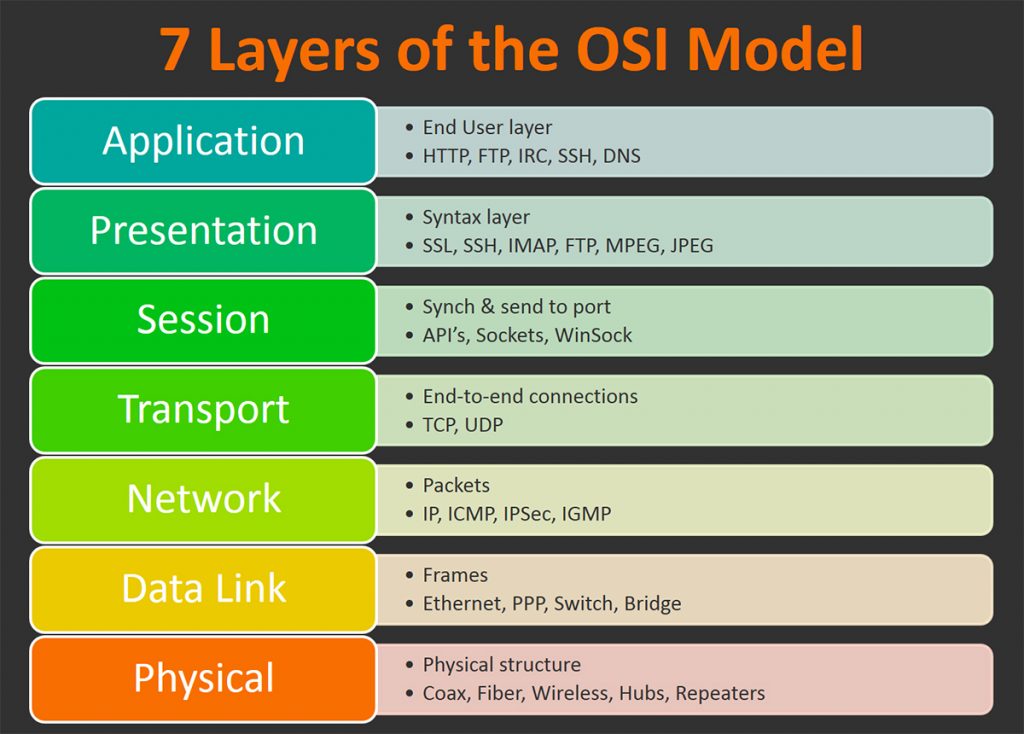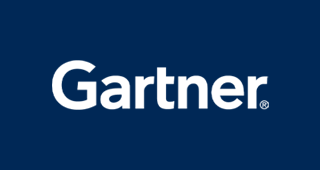With qos routing different __________ are defined, each with different priorities. ✅ Tốt
Kinh Nghiệm Hướng dẫn With qos routing different __________ are defined, each with different priorities. Chi Tiết
Hoàng Thế Quang đang tìm kiếm từ khóa With qos routing different __________ are defined, each with different priorities. được Cập Nhật vào lúc : 2022-11-24 16:00:12 . Với phương châm chia sẻ Bí kíp về trong nội dung bài viết một cách Chi Tiết 2022. Nếu sau khi tham khảo nội dung bài viết vẫn ko hiểu thì hoàn toàn có thể lại phản hồi ở cuối bài để Tác giả lý giải và hướng dẫn lại nha. Nội dung chính Show
Nội dung chính Show - 1. Physical2. Data Link4. Transport6. Presentation7. ApplicationThe internet doesn’t welcome OSIAdditional resourcesAccess the 2022 Gartner® Magic Quadrant™ for ITSMBMC Brings the A-GameYou may also likeAbout the authorWhen using dynamic routing routing decisions are always?Which file on the router defines what types of packets should be routed and what types of packets should be discarded?Which protocol performs linking to the application layer processes quizlet?Is used by a computer to determine how messages will travel through the network?
The Open Systems Interconnection (OSI) Reference Model is a conceptual framework that describes functions of the networking or telecommunication system independently from the underlying technology infrastructure. It divides data communication into seven abstraction layers and standardizes protocols into appropriate groups of networking functionality to ensure interoperability within the communication system regardless of the technology type, vendor, and model.
The OSI model was originally developed to facilitate interoperability between vendors and to define clear standards for network communication. However, the older TCP/IP model remains the ubiquitous reference framework for Internet communications today.
This image illustrates the seven layers of the OSI model. Below, we’ll briefly describe each layer, from bottom to top.

1. Physical
The lowest layer of the OSI model is concerned with data communication in the form of electrical, optic, or electromagnetic signals physically transmitting information between networking devices and infrastructure. The physical layer is responsible for the communication of unstructured raw data streams over a physical medium. It defines a range of aspects, including:
- Electrical, mechanical, and physical systems and networking devices that include specifications such as cable size, signal frequency, voltages, etc.Topologies such as Bus, Star, Ring, and MeshCommunication modes such as Simplex, Half Duplex, and Full DuplexData
transmission performance, such as Bit Rate and Bit SynchronizationModulation, switching, and interfacing with the physical transmission mediumCommon protocols including Wi-Fi, Ethernet, and othersHardware
including networking devices, antennas, cables, modem, and intermediate devices such as repeaters and hubs
2. Data Link
The second layer of the OSI model concerns data transmission between the nodes within a network and manages the connections between physically connected devices such as switches. The raw data received from the physical layer is synchronized and packaged into data frames that contain the necessary protocols to route information between appropriate nodes. The data link layer is further divided into two sublayers:
- The Logical Link Control (LLC) sublayer is responsible for flow controls and error controls that ensure error-không lấy phí
and accurate data transmission between the network nodes.The Media Access Control (MAC) sublayer is responsible for managing access and permissions to transmit data between the network nodes. The data is transmitted sequentially and the layer expects acknowledgement for the encapsulated raw data sent between the nodes.
3. Network
The third layer of the OSI model organizes and transmits data between multiple networks.
The network layer is responsible for routing the data via the best physical path based on a range of factors including network characteristics, best available path, traffic controls, congestion of data packets, and priority of service, among others. The network layer implements logical addressing for data packets to distinguish between the source and destination networks.
Other functions include encapsulation and fragmentation, congestion controls, and error handling. The outgoing data is divided into packets and incoming data is reassembled into information that is consumable a higher application level. Network layer hardware includes routes, bridge routers, 3-layer switches, and protocols such as Internet (IPv4) Protocol version 4 and Internet Protocol version 6 (IPv6).
4. Transport
The fourth layer of the OSI model ensures complete and reliable delivery of data packets.
- The transport layer provides mechanisms such as error control, flow control, and congestion control to keep track of the data packets, check for errors and duplication, and resend the information that fails delivery. It involves the service-point addressing function to ensure that the packet is sent in response to a
specific process (via a port address).Packet Segmentation and reassembly ensure that the data is divided and sequentially sent to the destination where it is rechecked for integrity and accuracy based on the receiving sequence.
Common protocols include the Transmission Control Protocol (TCP) for connection-oriented data transmission and User Datagram Protocol (UDP) for connectionless data transmission.
5. Session
As the first of three layers that giảm giá with the software level, the session layer manages sessions between servers to coordinate communication. Session refers to any interactive data exchange between two entities within a network. Common examples include HTTPS sessions that allow Internet users to visit and browse websites for a specific time period. The Session Layer is responsible for a range of functions including opening, closing, and re-establishing session activities, authentication and authorization of communication between specific apps and servers, identifying full-duplex or half-duplex operations, and synchronizing data streams.
Common Session Layer protocols include:
- Remote
procedure call protocol (RPC)Point-to-Point Tunneling Protocol (PPTP)Session Control Protocol (SCP)Session Description Protocol (SDP), as described here
6. Presentation
The sixth layer of the OSI model converts data formats between applications and the networks. Responsibilities of the presentation layer include:
- Data conversionCharacter code translationData compressionEncryption and decryption
The presentation layer, also called the syntax layer, maps the semantics and syntax of the data such that the received information is consumable for every distinct network entity. For example, the data we transfer from our encryption-based communication app is formatted and encrypted this layer before it is sent across the network.
At the receiving end, the data is decrypted and formatted into text or truyền thông information as originally intended. The presentation layer also serializes complex information into transportable formats. The data streams are then deserialized and reassembled into original object format the destination.
7. Application
The application layer concerns the networking processes the application level. This layer interacts directly with end-users to provide support for email, network data sharing, file transfers, and directory services, among other distributed information services. The upper most layer of the OSI model identifies networking entities to facilitate networking requests by end-user requests, determines resource availability, synchronizes communication, and manages application-specific networking requirements. The application layer also identifies constraints the application level such as those associated with authentication, privacy, quality of service, networking devices, and data syntax.
Common application layer protocols include:
- File Transfer Protocol (FTP)Simple Mail Transfer Protocol (SMTP)Domain Name System (DNS)
The internet doesn’t welcome OSI
The OSI model is widely criticized for an inherent implementation complexity that renders networking operations inefficient and slow. The academic approach to developing the OSI protocol suite relied on replacing existing protocols across all communication layers with better alternatives.
This approach failed to gain traction in the industry; vendors had already invested significant resources in TCP/IP products and had to manage interoperability with the vast choices of protocols and specifications offered by the OSI model. Additionally, academia itself considered the OSI model as an invention politically inspired by the European telecommunication and U.S. government authorities.
The older TCP/IP architecture model had already itself in real-world network environments. It served as a solid foundation for the Internet–including all of the security, privacy, and performance-related challenges. Continued research and development, investments, and industry-wide adoption of the OSI model could have made today’s cyber world a different (and perhaps better) place, but the pragmatism of the TCP/IP model gave us the internet that prevails today.
Additional resources
Learn more with these resources:
- BMC IT Operations BlogIT Infrastructure Management:
An IntroductionIT Infrastructure Planning: Getting StartedNetwork Engineer vs Network Administrator: Roles, Responsibilities, and Job DescriptionsWhat Is a Virtual Network?
Osi model 7 Layers from Siddique Ibrahim
Original reference image:

Access the 2022 Gartner® Magic Quadrant™ for ITSM
The Gartner Magic Quadrant for ITSM is the gold-standard resource helping you understand the strengths of major ITSM software vendors, insights into platform capabilities, integration opportunities, and many other factors to determine which solution best fits your needs.

These postings are my own and do not necessarily represent BMC's position, strategies, or opinion.
See an error or have a suggestion? Please let us know by emailing .
BMC Brings the A-Game
BMC works with 86% of the Forbes Global 50 and customers and partners around the world to create their future. With our history of
innovation, industry-leading automation, operations, and service management solutions, combined with unmatched flexibility, we help organizations không lấy phí up time and space to become an Autonomous Digital Enterprise that conquers the opportunities ahead.
Learn more about BMC ›
You may also like
About the author
Muhammad Raza is a Stockholm-based technology consultant working with leading startups and Fortune 500 firms on thought leadership branding projects across DevOps, Cloud, Security and IoT.
When using dynamic routing routing decisions are always?
When using dynamic routing, routing decisions are always made by a central host or server. Subnet masks tell computers what part of an IP address is to be used to determine whether a destination is in the same subnet or in a different subnet.Which file on the router defines what types of packets should be routed and what types of packets should be discarded?
Access Control List (ACL) defines what types of packets should be routed and what types of packets should be discarded.. address resolution. ... . Address Resolution Protocol (ARP) ... . addressing. ... . application layer address (URL) ... . autonomous systems. ... . Border Gateway Protocol (BGP) ... . border router..Which protocol performs linking to the application layer processes quizlet?
TCP is the network layer protocol used on the Internet today. IP is responsible for error-không lấy phí delivery of packets on a TCP/IP network. The TCP portion of TCP/IP performs linking to the application layer.Is used by a computer to determine how messages will travel through the network?
The Internet Protocol (IP) is the protocol that describes how to route messages from one computer to another computer on the network. Each message is split up into packets, and the packets hop from router to router on the way to their destination. Tải thêm tài liệu liên quan đến nội dung bài viết With qos routing different __________ are defined, each with different priorities.